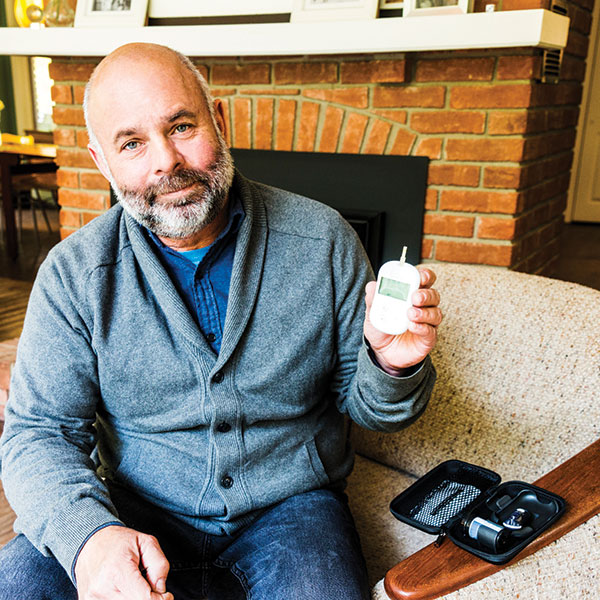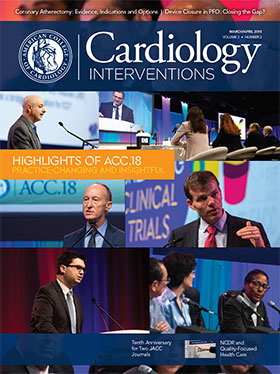JACC in a Flash | Featured Topics and Editors' Picks From All of ACC's JACC Journals
Urgent/Emergent TAVR Has Acceptable Outcomes Compared With Elective TAVR

Urgent or emergent transcatheter aortic valve replacement (TAVR) was feasible and had acceptable outcomes, according to results of an STS/ACC TVT registry study presented by Dhaval Kolte, MD, PhD, at ACC.18. The results were simultaneously published in JACC: Cardiovascular Interventions.
Using data from the STS/ACC TVT registry for TAVR procedures performed from 2011 to 2016, the study cohort was categorized into urgent/emergent TAVR or elective TAVR. The primary endpoint was in-hospital, 30-day and one-year all-cause mortality. Secondary endpoints included device success, acute kidney injury (AKI), major or life-threatening bleeding and multiple cardiovascular outcomes. Read more >>>
Among the 40,042 patients who underwent TAVR, 36,090 (90.1 percent) were elective and 3,952 (9.9 percent) were urgent/emergent. Patients undergoing urgent/emergent TAVR had lower left ventricular ejection fraction (LVEF) and were more likely to have moderate-to-severe valve insufficiency than those undergoing elective TAVR. Significantly more urgent/emergent TAVR patients had planned valve-in-valve TAVR for degenerated previously implanted bioprostheses. Use of mechanical circulatory support, cardiopulmonary bypass and transapical or transaortic access site was more common in urgent/emergent TAVR.
Patients in the urgent/emergent TAVR vs. elective TAVR group had higher intra-procedural mortality (0.96 vs. 0.49 percent) and in-hospital mortality (6.1 vs. 3.0 percent). In-hospital mortality was lower than predicted by the STS/TVT Registry model for both urgent/emergent and elective TAVR. The device success rate was significantly lower with urgent/emergent vs. elective TAVR (92.6 vs. 93.7 percent).
Patients in the urgent/emergent vs. elective TAVR group had significantly higher rates of AKI (7.0 vs. 3.7 percent). Length of stay was significantly longer after urgent/emergent TAVR than elective TAVR. Patients in the urgent/emergent TAVR group were more likely to be discharged to a skilled nursing facility or extended care or rehabilitation unit.
The median follow-up was 338 days for the urgent/emergent TAVR group and 394 days for the elective group. Thirty-day mortality was significantly higher among patients who underwent urgent/emergent vs. elective TAVR (8.7 vs. 4.3 percent). Patients in the urgent/emergent TAVR vs. elective TAVR group also had higher one-year mortality (29.1 vs. 17.5 percent). Factors independently associated with an increased risk of 30-day and one-year mortality in the urgent/emergent TAVR group included oxygen-dependent lung disease, atrial fibrillation or flutter, use of cardiopulmonary bypass during TAVR, and nonfemoral access site. Use of a balloon-expandable valve was inversely associated with 30-day and one-year mortality.
Acute device success after urgent/emergent TAVR was high and clinically similar with elective TAVR. Mortality rates were higher among patients undergoing urgent/emergent TAVR compared with elective TAVR. The authors concluded that urgent/emergent TAVR is feasible with acceptable outcomes and may be a reasonable option in a select group of patients with severe aortic stenosis.
Kolte D, Khera S, Vemulapalli S, et al. JACC: Cardiovasc Interv 2018:March 11:[Epub ahead of print].
PHARMCLO: Outcomes Improved With Genotyping to Select Antiplatelet Therapy
Genotyping to inform selection of antiplatelet therapy in patients with acute coronary syndrome (ACS) improved outcomes compared with the standard of care, according to results presented by Diego Ardissino, MD, FACC, at ACC.18 and simultaneously published in the Journal of the American College of Cardiology.
Patients with ACS were randomly assigned to P2Y12 receptor antagonist selection based on genotyping and clinical characteristics (n=448) or clinical characteristics alone (n=440), the current standard of care. Patients in the genotyping group were tested for ABCB1 3435, CYP2C19*2 and CYP2C19*17 using the portable ST Q3 system. Antiplatelet selection was ultimately decided by the prescriber. The primary endpoint was the composite of cardiovascular death and the first occurrence of nonfatal myocardial infarction (MI), nonfatal stroke and BARC 3 to 5 major bleeding within 12 months. Read more >>>
Enrollment was prematurely stopped by the Ethics Committee after 24.6 percent of the prespecified sample size was enrolled because of the lack of in vitro diagnosis certification for the ST Q3 instrument. All patients were followed as planned. The differences in antiplatelet prescribing for the genotyping vs. standard care were statistically significant: clopidogrel, 43.3 vs. 50.7 percent; prasugrel, 7.6 vs. 8.4 percent; and ticagrelor, 42.6 vs. 32.7 percent.
The primary endpoint occurred in significantly fewer genotyping vs. standard care patients (15.9 vs. 25.9 percent). Stent thrombosis occurred in eight patients, not enough for analysis. Ischemic endpoints occurred in significantly fewer genotyping vs. standard care patients (13.0 vs. 21.4 percent). Bleeding endpoints occurred more often in the genotyping than standard care group (4.2 vs. 6.8 percent; not significant).
“Selecting treatment on the basis of genetic data in addition to considerations concerning the patients’ clinical characteristics may lead to a more personalized, and therefore more efficient, antiplatelet therapy, thus reducing both ischemic and bleeding risk,” said Ardissino. “The study, while provocative, was underpowered to detect the endpoint we most fear: stent thrombosis. We need larger trials to know if this strategy works for this critical endpoint,” said Kim A. Eagle, MD, MACC, editor-in-chief of ACC.org.
Notarangelo FM, Maglietta G, Bevilacqua P, et al. J Am Coll Cardiol 2018;March 11:[Epub ahead of print].
Automated Algorithm Using Smartwatch Technology Accurately Detects Atrial Fibrillation

The Kardia Band (KB) smartwatch automated algorithm for detection of atrial fibrillation (AFib), supported by physician review of the recordings, reliably differentiates AFib from sinus rhythm (SR), according to results of a single-center study presented by Joseph M. Bumgarner, MD, at ACC.18. The results were published simultaneously in the Journal of the American College of Cardiology.
The KB handheld cardiac rhythm recorder is a smartwatch accessory that records a rhythm strip equivalent to lead I for 30 seconds and has an algorithm for instantaneous diagnosis of AFib. The study examined whether the KB could differentiate SR from AFib compared with physician-interpreted 12-lead electrocardiogram (ECG) and KB recordings. Read more >>>
A total of 100 consecutive patients with AFib scheduled for cardioversion received a KB connected to a smartwatch paired via Bluetooth to a smartphone. The patients underwent pre-cardioversion ECG followed immediately by KB recording. If cardioversion was performed, post-cardioversion and KB recordings were obtained. The KB algorithm measures rhythm irregularity and P wave absence in real time to classify the rhythm strip as “possible AFib.” The automated KB interpretations were compared with electrophysiologist-interpreted KB rhythm strips and simultaneous ECGs.
Cardioversion was performed in 85 percent of the patients. A total of 169 simultaneous 12-lead ECG and KB recordings were obtained, of which 57 were unclassified by the KB algorithm. Of the classified KB strips, KB correctly diagnosed AFib with 93 percent sensitivity, 84 percent specificity and a K coefficient of 0.77 compared with electrophysiologist-interpreted 12-lead ECG. Electrophysiologist interpretation of KB recordings had 99 percent sensitivity, 83 percent specificity and a K coefficient of 0.83. Of the 57 KB unclassified recordings, the electrophysiologists correctly diagnosed AFib with 100 percent sensitivity, 80 percent specificity and a K coefficient of 0.74. Among interpretable KB recordings, the KB and electrophysiologist agreement was excellent (K coefficient 0.88).
While the results demonstrated the reliable differentiation of AFib from SR with the KB automated algorithm supported by physician review of the recordings, the authors note that the small sample size at their tertiary referral center had a known history of AFib with a burden sufficient to prompt electrical cardioversion. “The performance of the KB smartwatch algorithm may be more variable in a population with a lower AFib burden,” they wrote. Other factors that may affect the generalizability of the results are the low representation of women, exclusion of patients with cardiac implantable electronic devices and lack of prior use the KB by participants. The Kardia Band has been approved by the U.S. Food and Drug Administration.
Bumgarner JM, Lambert CT, Hussein AA, et al. J Am Coll Cardiol 2018;March 10:[Epub ahead of print].
Male Sex and Diabetes Predict Sudden Death in Patients with HFpEF

Male sex and insulin-treated diabetes were independently associated with sudden death (SD) in patients with heart failure with preserved ejection fraction (HFpEF), which accounted for 19 percent of deaths in a TOPCAT trial analysis presented by Muthiah Vaduganathan, MD, MPH, at ACC.18. The results were published simultaneously in JACC: Heart Failure.
The competing risk analysis investigated the incidence rates of the composite of SD or aborted cardiac arrest (ACA), unique predictors of SD or ACA, and response to spironolactone in patients with HFpEF. This analysis was performed in the TOPCAT patient cohort from the Americas, which included 1,767 patients. All eligible patients had a left ventricular ejection fraction (LVEF) ≥45 percent. The patients were randomized to either spironolactone or matching placebo. Predictors of composite SD and ACA were identified using a step-wise backward selection with competing risks regression analysis accounting for non-SD causes of death. Read more >>>
During a median 3.0 years of follow-up, a total of 385 patients died, of whom 19 percent were due to SD and 81 percent to non-SD causes. Six ACA events occurred during that time. During 5,426 person-years of observation, incidence rates of SD/ACA vs. non-SD/ACA were 1.4 and 5.8 events/100 patient-years, respectively.
Patients with SD/ACA were younger, male and had higher body mass indexes and rates of diabetes. The final competing risks regression model showed that male sex and insulin-treated diabetes were independent predictors of SD/ACA with modest discrimination. Male sex and insulin-treated diabetes remained independent predictors of SD/ACA in sensitivity analyses excluding patients with implantable cardioverter-defibrillators and when predicting SD alone.
Incidence rates of SD/ACA in patients receiving spironolactone vs. placebo were 1.2 vs. 1.6 per patient-years, respectively. Competing risks regression analysis showed that the difference between the treatment groups was not statistically significant.
The authors concluded that further studies are needed to define mechanisms contributing to SD, build more robust SD risk prediction models integrating imaging and biomarkers, and develop strategies to attenuate SD risk in patients with HFpEF.
Vaduganathan M, Claggett BL, Chatterjee NA, et al. JACC: Heart Fail 2018:March 11:[Epub ahead of print].
Therapy-Related Changes in Natriuretic Peptides Inconsistently Predict Outcomes
Therapy-related changes in natriuretic peptides (NPs) modestly correlated with longer-term treatment effects on hospitalization for heart failure (HF) but not with effects on all-cause mortality, according to results of a study presented by Muthiah Vaduganathan, MD, MPH, at ACC.18. The results were also published in JACC: Heart Failure.
A trial-level analysis was conducted of 16 phase III randomized HF trials including 48,844 patients. Trial-level estimates of treatment effects on NPs and clinical outcomes were determined using data on the change in NPs in the two treatment groups over ≥1 month follow-up. The analysis focused on data for all-cause mortality and hospitalization for HF. Between-group differences in the change in log-transformed NPs were plotted against the magnitude of the treatment effect on clinical endpoints. Weighted Pearson correlation coefficients were calculated for average control- or placebo-corrected changes in NPs and the longer-term treatment effects on clinical endpoints. Read more >>>
The median follow-up for clinical endpoints was 28 months. NP data were available for a median 748 patients. The analysis showed that treatment-induced changes in NPs were not well correlated with treatment effects on all-cause mortality (weighted r=0.12). No correlations between changes in NPs and treatment effects on all-cause mortality were observed according to timing of NP sampling and other major trial factors.
Treatment-induced effects on NPs were signficantly correlated with treatment effects on hospitalization for HF (weighted r=0.63). Correlations between NP changes and treatment effects were consistently observed with respect to timing of NP assessment. Significant correlations between NP changes and hospitalization for HF were observed across key trial-level subgroups, including trials completed in the last decade, trials using NT-proBNP assays, and trials assessing renin-angiotensin-aldosterone system inhibitors.
According to the investigators, this analysis highlights issues with reliance on short-term NP changes in phase II trials to predict the long-term response in a subsequent phase III trial. “The use of NPs cannot reliably be utilized to estimate the probable effect of a drug or device on the risk of death,” they wrote.
The investigators urged caution in using NPs as the primary strategy for decision-making in phase II trials or for determining the most appropriate drug doses to evaluate in phase III trials.
In an editorial comment, James L. Januzzi Jr., MD, FACC, wrote “The authors found changes in NP concentrations were surprisingly not correlated to effect of treatment on all-cause mortality, but appeared modestly correlated to occurrence of HF hospitalization. The correlation with hospitalization was much stronger in studies of renin-angiotensin-aldosterone system inhibitors.” Their results affirm that more knowledge is required before biomarkers can be acceptable clinical trial endpoints.
Vaduganathan M, Claggett B, Packer M, et al. JACC: Heart Fail 2018;March 11:[Epub ahead of print].
Partners YOUNG-MI: Cocaine, Marijuana Use Associated with Worse Mortality in Younger Patients After MI

Cocaine or marijuana use was associated with worse all-cause and cardiovascular mortality among younger patients who experienced a myocardial infarction (MI). This was the finding from the Partners YOUNG-MI study presented by Ersilia M. DeFilippis, MD, at ACC.18 and simultaneously published in the Journal of the American College of Cardiology.
The retrospective registry study assessed the prevalence of cocaine and marijuana use and its association with outcomes in young adults presenting with their first MI at ≤50 years of age. Patients who used both drugs were included in the cocaine group for the analysis. The primary endpoints were cardiovascular and all-cause mortality. Secondary endpoints included cardiac arrest at presentation and coronary revascularization. Read more >>>
The study included 2,097 patients with Type I MI. Cocaine or marijuana use was present in 10.7 percent of patients, with 4.7 percent using marijuana and 6.0 percent using cocaine. Both substances were used by 36 patients. Patients with substance use were younger and male. A significantly higher percentage of STEMIs occurred in the substance use group vs. the non-substance use group (64.7 vs. 52.1 percent).
Patients with substance use had significantly lower rates of diabetes and hyperlipidemia but significantly higher rates of tobacco use.
Out-of-hospital cardiac arrest occurred significantly more often in patients with substance use vs. those without (8.0 vs. 3.5 percent). This difference was largely driven by increased cardiac arrest in the marijuana group. There were no significant differences in the rates of coronary revascularization.
During a median follow-up of 11.2 years, patients with substance use had significantly higher all-cause mortality vs. those without (18.8 vs. 11.3 percent). The adjusted hazard ratios for all-cause death were 1.99 for any substance use, 2.09 for marijuana and 1.91 for cocaine. Cardiovascular mortality was significantly higher among patients with substance use vs. those without (9.4 vs. 5.3 percent). The adjusted hazard ratios for cardiovascular death were 2.22 for any substance use, 2.13 for marijuana use and 2.32 for cocaine use.
“These findings reinforce current recommendations for screening for substance abuse among adults who experience an MI at a young age, and highlight the need for implementation of therapies and counseling that could prevent future adverse events,” write the authors.
DeFilippis EM, Singh A, Divakaran S, et al. J Am Coll Cardiol 2018;March 10:[Epub ahead of print].
Keywords: ACC Publications, Cardiology Interventions, Acute Coronary Syndrome, Acute Kidney Injury, Adenosine, Algorithms, Aortic Valve, Aortic Valve Stenosis, Atrial Fibrillation, Biomarkers, Bioprosthesis, Cannabis, Cardiopulmonary Bypass, Cause of Death, Certification, Cocaine, Cocaine-Related Disorders, Counseling, Death, Sudden, Decision Making, Defibrillators, Implantable, Diabetes Mellitus, Electric Countershock, Electrocardiography, Ethics Committees, Factor V, Follow-Up Studies, Genotype, Heart Arrest, Heart Failure, Heart Valve Diseases, Heart Valve Prosthesis, Hospital Mortality, Hospitalization, Hyperlipidemias, Incidence, Insulin, Length of Stay, Lung Diseases, Marijuana Abuse, Marijuana Smoking, Myocardial Infarction, Natriuretic Peptide, Brain, Natriuretic Peptides, Out-of-Hospital Cardiac Arrest, Oxygen, Peptide Fragments, Prevalence, Purinergic P2Y Receptor Antagonists, Registries, Regression Analysis, Renin-Angiotensin System, Research Personnel, Retrospective Studies, Sample Size, Skilled Nursing Facilities, Spironolactone, Standard of Care, Stents, Stroke, Stroke Volume, Tertiary Care Centers, Thrombosis, Ticlopidine, Tobacco Use, Tomography, X-Ray Computed, Transcatheter Aortic Valve Replacement, United States Food and Drug Administration
< Back to Listings

